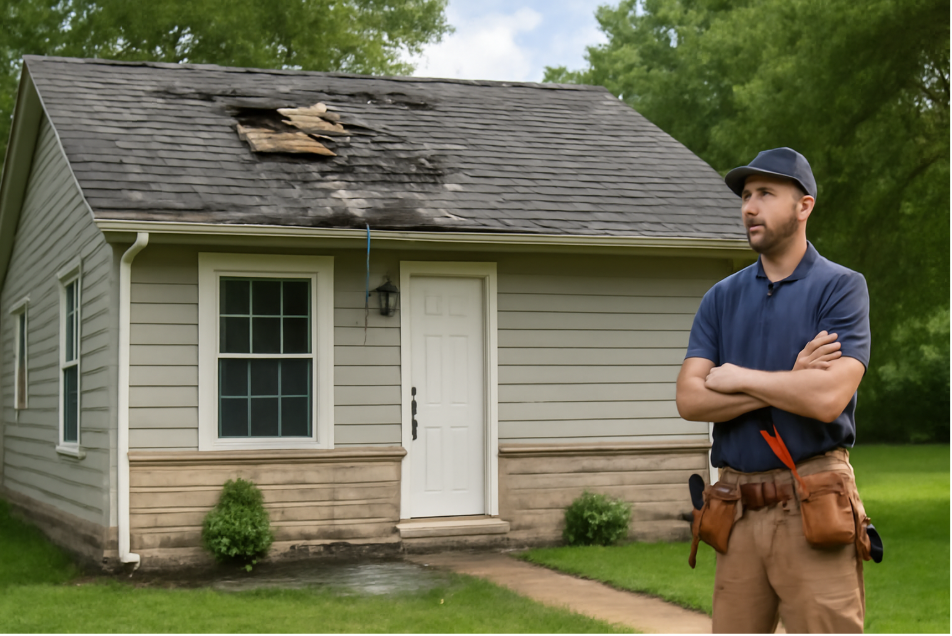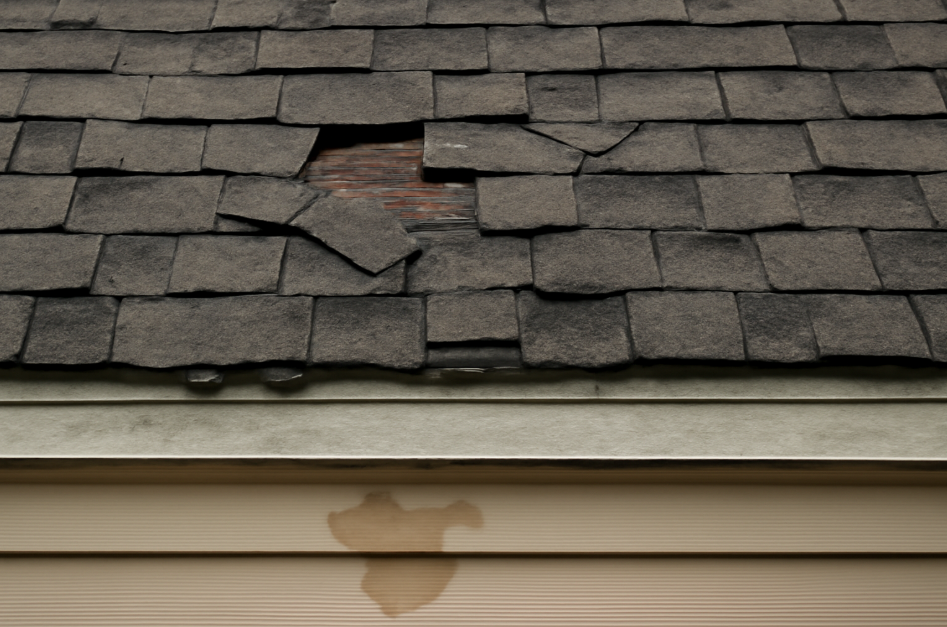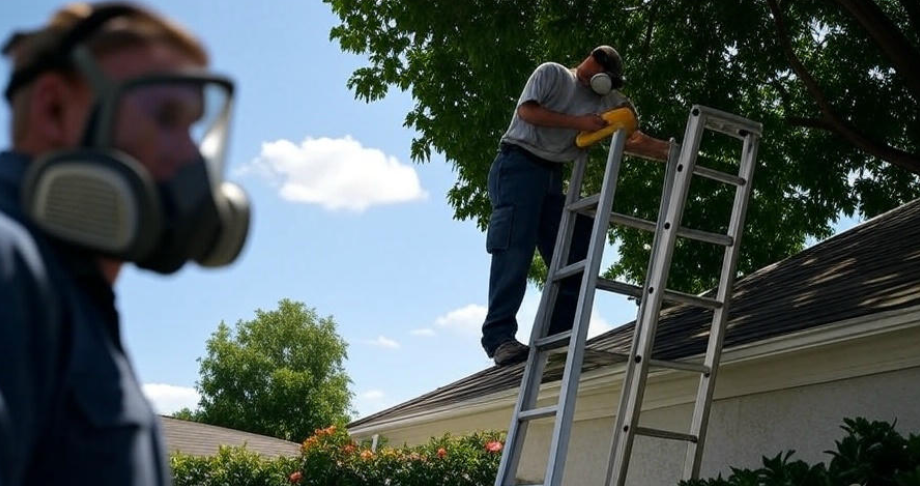
Expert Tips for Repairing a Damaged Roof: Step-by-Step Guide for Homeowners
Is your roof showing signs of wear and tear? A damaged roof can quickly turn into a costly disaster if not addressed promptly. Whether it’s a small leak, missing shingles, or a major crack, tips for repairing a damaged roof can help prevent further damage and protect your home from costly repairs. 🛠️
But don’t panic—repairing a roof doesn’t have to be a daunting task! In this expert guide, we’ll walk you through easy-to-follow steps to assess, fix, and maintain your roof, saving you time and money. From simple DIY fixes to when to call in a professional, we’ll ensure you have all the knowledge you need to keep your roof in top shape.
Ready to protect your home? Let’s dive into the most practical, cost-effective solutions for repairing your roof! 🌟
Table of Contents
ToggleIdentifying Roof Damage – What to Look For 🔍
Before jumping into repairs, it’s essential to first identify the extent of the damage. Catching roof problems early can save you from more costly fixes down the road. Here are the key signs you should look for when inspecting your roof:

1. Missing or Damaged Shingles 🏚️
One of the most common indicators of roof damage is missing or broken shingles. Whether they’ve blown off in a storm or cracked over time, damaged shingles can leave your roof vulnerable to leaks and further deterioration. If you notice any gaps or pieces that are curled up, it’s time for a fix!
2. Water Stains Inside the Home 💧
If you see water stains on your ceilings or walls, especially after rain, it’s a clear sign of roof leaks. Check the attic or upper floors to trace the leak’s origin. Water stains can often signal issues with your roof’s integrity, like cracks or improperly sealed areas.
3. Sagging Roof Deck 🏠
A sagging roof is a serious issue that shouldn’t be ignored. If you notice a dip or sag in your roofline, this could indicate a structural problem. Moisture accumulation or damage to the trusses can cause a roof to sag, which may need immediate attention.
4. Mold and Mildew Growth 🍄
Mold and mildew in your attic or on your roof often indicate trapped moisture. If you smell musty odors or see visible mold growth, it’s a sign that water is sitting on your roof for too long. This can weaken your roof and lead to more severe damage over time.
5. Loose or Damaged Flashing 🔧
Flashing is the material around chimneys, vents, and skylights. If it’s cracked, loose, or missing, water can easily get underneath and cause leaks. Check these areas regularly to ensure the flashing is intact and properly sealed.
6. Granules in the Gutter 🌧️
If your roof is covered with asphalt shingles, you might notice small granules accumulating in your gutters. These granules protect your shingles from the sun’s harmful UV rays. Excessive granule loss is a sign that the shingles are wearing out and need replacement.
How to Inspect Your Roof Safely
When checking for damage, safety comes first. Use a sturdy ladder and make sure the weather is clear—avoid inspecting your roof during windy or rainy conditions. If your roof is steep or difficult to access, it might be a good idea to hire a professional.
Assessing the Extent of the Damage 🧐
Once you’ve identified signs of roof damage, the next step is assessing how severe it is. This helps you determine whether the problem can be fixed with a simple DIY repair or if you need professional help. Here’s how to evaluate the damage:

1. Minor Damage – Fixable with DIY Repairs 🔨
Minor roof damage typically includes small issues like missing or cracked shingles, leaks in specific areas, or small holes. These are often easy to repair on your own, and the materials needed are relatively inexpensive.
- Cracked or Curling Shingles: If a few shingles are cracked or curling, you can usually replace them yourself. Ensure that the replacement shingles match the color and style of your existing roof for the best results.
- Small Leaks: If you notice small water stains or leaks, this could be due to missing or damaged shingles, flashing, or sealant around vents. Sealing small gaps with roofing cement or replacing a few shingles might be enough to fix it.
2. Moderate Damage – Requires More Effort 🛠️
Moderate damage often includes larger leaks, a few missing shingles across multiple sections, or damaged flashing. These repairs may require more time and effort, but they’re still manageable for an experienced DIYer.
- Leaks in Multiple Areas: If multiple areas are leaking, it may indicate widespread damage that needs to be repaired to prevent further leaks. Consider patching the leaks or replacing sections of the roofing material.
- Damaged Flashing: Flashing that has become loose or cracked may need to be re-secured or replaced. While this is still a manageable fix, it could involve some additional tools and expertise.
3. Major Damage – Professional Help Needed 🏗️
Major roof damage is typically associated with significant structural issues or severe weather-related damage, such as large holes, widespread leaks, or sagging roofs. This kind of damage requires a professional roofer to assess and repair the problem.
- Structural Damage or Sagging Roof: If your roof deck is sagging, it indicates a structural issue that could compromise the entire roof’s stability. This requires immediate attention from a professional to avoid further damage to your home.
- Extensive Shingle Damage: If more than 30% of your roof is damaged, it may be time to consider a full roof replacement. Large sections of missing shingles can leave your home vulnerable to leaks and costly repairs down the line.
4. When to Call in a Professional 📞
If the damage appears widespread, affects the structure of your roof, or feels beyond your skill level, it’s time to call a professional. Roofing contractors have the necessary experience and equipment to safely assess and repair major issues.
Step-by-Step Guide to Repairing Minor Roof Damage 🛠️
If you’ve assessed your roof and found only minor damage, you’re in luck! Many small issues can be repaired on your own with a bit of time, the right tools, and some basic know-how. Here’s a simple, step-by-step guide to help you fix common roof problems like cracked shingles, small leaks, and loose flashing.

Step 1: Gather the Necessary Tools and Materials 🧰
Before you start, make sure you have everything you’ll need:
- Ladder (for safe access)
- Replacement shingles (if needed)
- Roofing nails or staples
- Roof cement or roofing sealant
- Hammer or staple gun
- Gloves and safety glasses
- Caulk or flashing repair tape (for leaks around vents and chimneys)
Step 2: Safety First – Set Up Your Ladder Correctly ⚠️
Always prioritize safety! Make sure your ladder is stable and positioned on a flat surface. Use a ladder stabilizer if necessary to avoid damaging your gutters. Wear safety gloves and glasses to protect yourself from debris and sharp objects.
Step 3: Inspect and Replace Damaged Shingles 🔨
If a few shingles are cracked, curling, or missing, here’s what to do:
- Lift the Shingle: Use a flat pry bar to lift the damaged shingle carefully. Don’t damage the ones underneath.
- Remove the Nails: Take out the nails securing the shingle with your hammer or pry bar.
- Replace the Shingle: Slide the new shingle into place, ensuring it lines up with the others. Secure it with roofing nails, making sure the nails are driven in flush with the shingle to avoid any leaks.
- Seal the Edges: Apply a small amount of roofing cement under the edges of the new shingle to ensure it’s firmly in place and prevent future lifting.
Step 4: Fix Small Leaks with Roof Sealant 💧
For minor leaks, roof sealant or cement can do the trick. Here’s how:
- Locate the Leak: If you’ve noticed water stains inside, trace the leak back to the damaged area of your roof.
- Clean the Area: Before applying any sealant, clean the area around the leak to ensure a secure bond.
- Apply the Sealant: Using a putty knife or caulk gun, apply a generous amount of roofing sealant over the crack, ensuring it covers the entire damaged area.
- Smooth the Sealant: Use the putty knife to smooth out the sealant, pressing it into the crack for a tight seal.
Step 5: Repair Flashing Around Vents and Chimneys 🔧
Loose or damaged flashing is a common cause of roof leaks. To fix it:
- Lift the Flashing: Carefully lift the damaged flashing with a flat bar.
- Apply Roof Cement: Spread roofing cement underneath the flashing to create a watertight seal.
- Reattach the Flashing: Press the flashing back into place and secure it with nails or screws if needed. Apply more cement over the edges to seal any gaps.
Step 6: Check for Gaps and Holes 🕳️
If there are any small holes or gaps in your roof:
- Clean the Area: Scrape off any debris or old roofing material.
- Apply a Patch: For small holes, you can use roofing cement or a patch kit. Apply the cement and smooth it out, covering the hole completely. If it’s a larger hole, use a patch of roofing material (such as a shingle or metal) and secure it with roofing nails, then seal the edges.
Step 7: Final Inspection and Clean-Up ✅
Once your repairs are complete, give your roof a final inspection to ensure everything is secure and properly sealed. Remove any excess roofing cement or debris, and store your tools safely.
When to Call a Professional Roofing Contractor 📞
While many roof repairs can be handled by homeowners, some issues are best left to the professionals. If you encounter any of the following situations, it’s time to call in an expert to avoid further damage or safety risks.

1. Extensive Structural Damage 🏚️
If your roof is sagging, warped, or showing signs of serious structural damage, it’s crucial to seek professional help. Structural issues could indicate that the roof’s support system is compromised, and attempting repairs without proper expertise could make the situation worse.
- Signs to look for: Visible dips or sagging, or parts of the roof that seem to be “bowing” under pressure.
- Why call a professional: Roofing contractors can assess the extent of the damage and ensure the roof is properly reinforced or replaced.
2. Widespread or Large-Scale Leaks 💧
A single small leak can often be fixed with a DIY approach, but multiple leaks or leaks covering a large area require professional attention. Extensive water damage can weaken the roof and lead to mold growth, structural damage, or even higher repair costs in the future.
- Signs to look for: Water stains on ceilings or walls in multiple rooms, or large puddles in the attic.
- Why call a professional: A roofing contractor can identify the root cause of the leaks, and recommend the best repair or replacement options.
3. Roof is Too Steep or Difficult to Access 🧗♂️
If your roof is steep, high, or simply too difficult to reach safely, it’s best to hire a professional. Roof repairs can be dangerous, especially if you don’t have the proper safety equipment or experience working at height.
- Signs to look for: A steep pitch, hard-to-reach areas, or limited access to the roof.
- Why call a professional: Contractors have the tools, safety gear, and experience to work safely on challenging roofs, minimizing the risk of accidents.
4. Extensive Shingle Damage or Missing Sections 🏠
If a significant portion of your roof is damaged (more than 30% of the shingles), it may be time to consider a full roof replacement. This is especially important if your roof has experienced damage from a severe storm or prolonged wear.
- Signs to look for: Widespread missing shingles, cracks, or damage affecting large areas.
- Why call a professional: A roofing expert can determine if a complete replacement is needed or if targeted repairs will suffice.
5. Uncertainty About the Cause of the Damage ❓
If you’re unsure about the cause of the roof damage or can’t pinpoint the source of leaks, a professional can perform a thorough inspection. Sometimes, damage may not be visible to the untrained eye, and a roofer can identify hidden problems like damage to the underlayment or internal structure.
- Signs to look for: Persistent leaks, water stains without obvious roof damage, or an unsure diagnosis.
- Why call a professional: Roofing contractors can diagnose the root cause of the problem and provide the right solution, preventing future issues.
6. Insurance or Warranty Claims 📑
If you’re filing an insurance claim for roof damage or your roof is still under warranty, it’s a good idea to hire a professional to ensure the repair work is done correctly. Some insurance companies or warranties require a licensed roofer to carry out the repairs to qualify for coverage.
- Signs to look for: Filing an insurance claim, dealing with roof warranties.
- Why call a professional: Roofing contractors are familiar with insurance and warranty processes, ensuring the job is done to meet requirements.
Preventing Future Roof Damage 🛡️
After you’ve repaired your roof, it’s essential to take proactive steps to prevent future damage. Regular maintenance and a few simple habits can help extend your roof’s life and save you from costly repairs down the road. Here’s how you can protect your roof and keep it in top shape for years to come:

1. Schedule Regular Roof Inspections 🔍
Roof inspections are crucial for catching potential issues before they turn into major problems. Aim to inspect your roof at least once or twice a year, and after any major storm or weather event.
- What to check for: Damaged shingles, debris buildup, and cracks in flashing. Keep an eye on the roof’s overall condition.
- Why it helps: Regular checks allow you to address small issues before they escalate into costly repairs.
2. Keep Your Gutters Clean 🍂
Clogged gutters are one of the leading causes of roof damage. When gutters get blocked with leaves, twigs, or debris, water can pool on your roof, leading to leaks, mold, and even structural damage.
- How to maintain: Clean your gutters at least twice a year, especially during fall when leaves are falling. Ensure downspouts are clear to allow water to flow freely.
- Why it helps: Clean gutters prevent water buildup and reduce the risk of water damage to your roof and foundation.
3. Trim Overhanging Trees 🌳✂️
Overhanging branches can damage your roof in several ways. Strong winds can cause branches to break and fall onto your roof, while constant rubbing can wear down shingles over time.
- How to maintain: Trim any branches that hang too close to your roof. If you have tall trees near your house, consider hiring a professional to keep them in check.
- Why it helps: Tree trimming protects your roof from physical damage and helps improve airflow, reducing the chances of mold or mildew growth.
4. Ensure Proper Attic Ventilation 🌬️
Poor attic ventilation can trap moisture and heat, leading to damage to both your roof and the structure of your home. Proper airflow helps prevent the buildup of humidity, which can cause shingles to warp and mold to develop.
- How to maintain: Make sure your attic has adequate vents, including soffit vents and roof vents. Check for any blockages or damage.
- Why it helps: Good ventilation helps regulate temperature and humidity, protecting your roof from moisture damage and extending its lifespan.
5. Apply a Protective Coating 🛡️
Consider applying a roof sealant or coating to protect your roof from the elements. These coatings add an extra layer of protection, keeping water and UV rays from damaging your shingles.
- How to apply: Hire a professional or follow the manufacturer’s instructions to apply a protective coating every few years.
- Why it helps: Roof coatings prevent weathering, reduce the risk of leaks, and extend the life of your shingles.
6. Fix Small Issues Promptly 🔧
When you notice small roof issues, like a loose shingle or tiny leak, don’t wait to address them. Small problems can quickly grow into bigger, more expensive repairs if left unchecked.
- What to do: Use roof sealant for small leaks or replace a single damaged shingle as soon as possible.
- Why it helps: Addressing small issues early prevents bigger, more expensive problems in the future.
How Much Does Roof Repair Cost? 💰
Understanding the cost of roof repairs is essential for homeowners. Roof repair prices can vary widely depending on the extent of the damage, the type of roof, and whether you’re doing it yourself or hiring a professional. Here’s a breakdown of what you can expect when budgeting for your roof repair:
1. Cost of Minor Roof Repairs 🛠️
For small issues like replacing a few shingles, fixing small leaks, or repairing flashing, the cost is usually more affordable.
- DIY Repairs: If you have the necessary tools and a bit of experience, minor repairs might cost between $100 and $500. This includes the price of materials like shingles, roofing cement, and sealant.
- Professional Repairs: Hiring a professional contractor for minor repairs typically costs between $200 and $700 depending on labor rates and the extent of the work.
2. Cost of Moderate Roof Repairs 🏚️
Moderate repairs, such as fixing larger sections of the roof, replacing damaged areas, or repairing extensive leaks, are more costly.
- DIY Repairs: For DIY repairs that involve replacing several shingles or fixing significant leaks, expect to spend between $500 and $1,500. You’ll need more materials like underlayment or plywood in some cases.
- Professional Repairs: A roofing contractor may charge between $1,000 and $3,000 for more extensive repairs, especially if they involve sections of the roof or require additional labor to fix structural issues.
3. Cost of Major Roof Repairs 🏠
For severe damage, such as sagging roofs, large leaks affecting multiple areas, or structural issues, repairs can be costly.
- DIY Repairs: It’s typically not recommended to handle major repairs yourself due to safety concerns and the complexity of the job. However, materials alone for major repairs could range from $2,000 to $5,000.
- Professional Repairs: Professional contractors may charge anywhere from $3,000 to $10,000 or more, depending on the extent of the damage and the roof type (e.g., metal, tile, asphalt shingles). This cost includes labor, materials, and disposal of old materials.
4. Roof Replacement Costs 🏡
If the damage is too extensive for repair, you might need to replace your roof entirely. Roof replacement is a significant investment.
- Cost of Replacement: Replacing a roof can cost anywhere from $5,000 to $25,000 or more. The cost depends on the size of your roof, the materials used (asphalt, metal, slate, etc.), and the complexity of the installation.
- Material Costs:
- Asphalt shingles: $3,000 to $10,000
- Metal roofing: $5,000 to $15,000
- Tile roofing: $10,000 to $25,000
5. Factors That Affect Roof Repair Costs 📊
Several factors can influence the final cost of your roof repair, including:
- Roof Size: Larger roofs require more materials and labor, increasing the overall cost.
- Roof Type: Different roofing materials (e.g., slate, metal, asphalt) come with different costs. Some are easier to repair, while others require specialized skills.
- Labor Costs: Labor rates vary depending on your location and the contractor’s experience.
- Severity of the Damage: The more severe the damage, the higher the repair costs due to the complexity of the work involved.
How to Save on Roof Repair Costs 💡
- Regular Maintenance: Preventing damage through routine inspections and repairs can save you money in the long run.
- Get Multiple Quotes: Always ask for quotes from at least three roofing contractors to compare prices and ensure you’re getting a fair deal.
- DIY Small Repairs: If you’re comfortable with DIY, consider fixing minor leaks or replacing a few shingles yourself to save on labor costs.

Repairing a damaged roof may seem overwhelming at first, but with the right knowledge and tools, you can take charge of your roof’s health and protect your home from further damage. Whether you’re tackling minor repairs yourself or calling in a professional for major issues, the key is to act promptly and address any signs of damage as soon as you spot them.
Remember, regular inspections, maintenance, and prompt repairs can extend the life of your roof and save you significant costs down the road. From fixing small leaks to knowing when to call in an expert, this guide has equipped you with the essential tips for keeping your roof in top shape.
Don’t wait for small problems to turn into big headaches. Take proactive steps today, and your roof will continue to protect your home for years to come. 😊
Stay safe, and happy repairing! 🌟
Frequently Asked Questions (FAQs)
1. What are the first steps to take when repairing a damaged roof?
When repairing a damaged roof, safety should be your priority. Begin by inspecting the damage carefully from the ground to avoid climbing right away. If you need to get on the roof, ensure you use a sturdy ladder and wear non-slip shoes. Next, assess the extent of the damage to determine whether it’s a DIY project or requires a professional.
2. Can I repair my roof myself, or should I hire a professional?
Minor roof repairs like replacing a few shingles can often be done by homeowners with basic tools. However, for larger issues such as leaks, structural damage, or if you’re unsure about your skills, it’s safer to hire a professional roofer to avoid further damage and potential safety risks.
3. What tools and materials do I need to repair a roof?
Common tools for DIY roof repairs include a ladder, hammer, roofing nails, shingles (if replacing), roof sealant, and a utility knife. Depending on the damage, you may also need a tarp to cover the area temporarily and roofing adhesive for sealing gaps.
4. How can I tell if my roof needs repair or replacement?
If you notice extensive leaks, missing shingles, sagging areas, or if your roof is over 20 years old, it may need replacement. For smaller issues like a few cracked or missing shingles, a repair might be sufficient. Consult a roofing professional for a thorough inspection if you’re unsure.
5. What should I do if I have a roof leak?
If you spot a leak, temporarily cover the area with a tarp to prevent further water damage. Then, locate the source of the leak by inspecting the roof, usually around vents, chimneys, or damaged shingles. It’s important to fix the leak as soon as possible to avoid structural damage or mold growth.
6. How long does it take to repair a roof?
The time it takes to repair a roof depends on the extent of the damage. Small repairs can be completed in a few hours, while more significant fixes may take a day or two. Larger projects, such as replacing a roof, could take several days depending on the roof size and complexity.
7. How much does it cost to repair a roof?
Roof repair costs vary depending on the damage type and materials used. Minor repairs can range from $150 to $500, while more extensive repairs may cost $1,000 or more. It’s important to get quotes from multiple roofing contractors to find the best price for your situation.
8. How can I prevent future roof damage?
Regular roof maintenance, such as cleaning gutters, inspecting for damage after storms, and trimming overhanging tree branches, can help prevent future issues. Also, applying a roof sealant or coating every few years can extend the lifespan of your roof and protect it from water damage.
